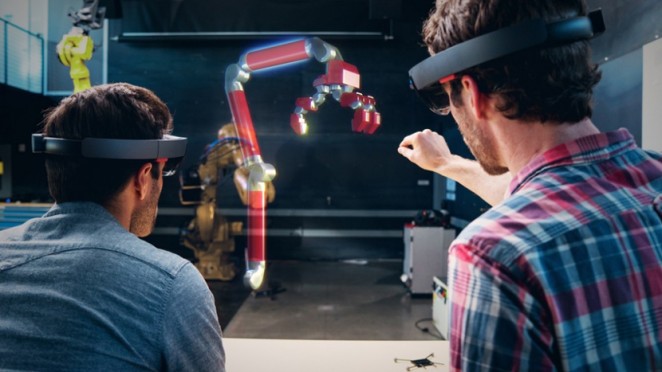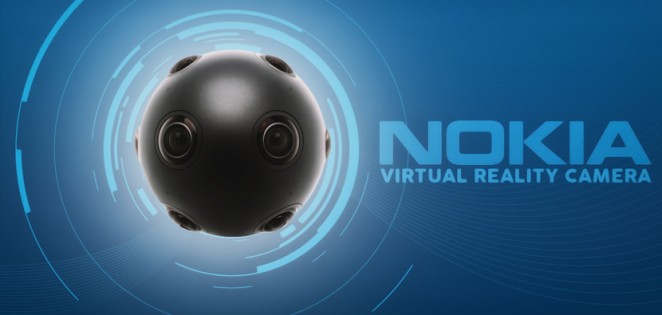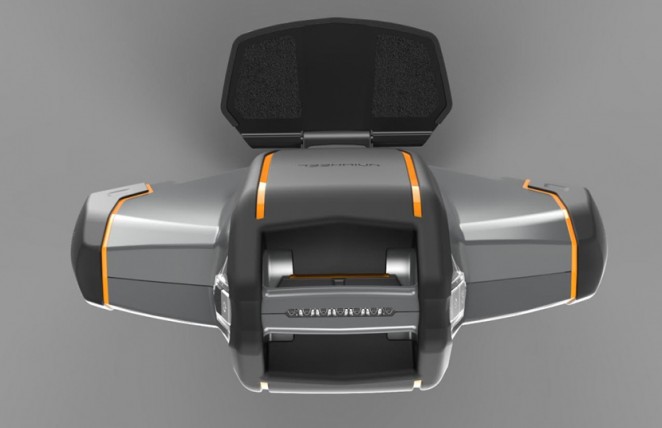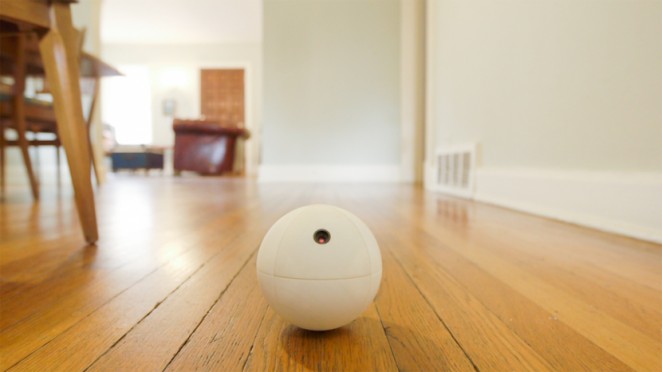GoPro get into the drone business
GoPro: Karma is Coming
Whilst I have yet to jump on the drone bandwagon myself, the immortal child inside me at least understands the appeal (to an extent), and given the ubiquity of GoPro amongst the hobbyist markets, it was only a matter of time before they threw their sizeable hat in the ring. The GoPro Karma (quite the name right?) is the company's first production run of a drone, though their cameras have already been used on drones for some time now, for everything from imitating superpowers to amateur dentistry.
The GoPro Karma is the company's first production run of a drone (or quadcopter)
GoPro CEO Nick Woodman confirmed that the company is moving into quadcopter (the official name, because Drone sounds oddly sinister) development at a Re/code conference back in May, but it was revealed this week through a sly teaser that the quadcopter will arrive next year. The footage from GoPro's teaser doesn't show what the drone may look like or what kind of equipment it's running, but it does give a pretty good idea of the kind of footage you can expect from the device. Currently, GoPro is holding a sweepstakes for the Karma, where those who enter will get a chance at one of 100 drones they are giving away to the public. You'll have to fight me for it though.
New VR development lets designers create physical objects out of thin air!

Ever fancied using thin air to sculpt a physical design? Well your prayers might finally have been answered thanks to a collaboration between Microsoft’s hologram headset HoloLens and design software Autodesk Fusion 360, which will allow designers to design 3D products by working on full size holograms. The project, which began last year, fuses elements of virtual and augmented reality, creating a virtual image of a real life object in a real-world environment. Both companies wanted to explore what could be possible for the every day designer or engineer using HoloLens, with general idea being to reduce both the time it takes to make products and the number of physical prototypes created, by improving the way designers, mechanical engineers and product developers work together. The HoloLens headset allows wearers to view imagery in 3D at high-definition and true size and scale, with the ability to move freely around it, whilst the Autodesk software will provide designers with a unique and intuitive set of tools that will make them feel as if they are literally sculpting products from thin air.
A collaboration between Microsoft’s HoloLens and design software Autodesk Fusion 360 will allow designers to design 3D products by working on full size holograms

While digital designers often use virtual reality to create immersive experiences for consumers, such as the recent wonder.land exhibition seen at the National Theatre and the recent Oculus Rift consumer launch, this exploration of the technology is aimed at helping designers in their every day working lives. A launch date for the HoloLens is yet to be announced. Developers and designers based in the US and Canada can currently apply to buy an early development edition of the headset for just under £2,000, and can expect to receive it by March 2016. Opinions are mixed on the potential of holographic 3D design of course. Digital designers generally agree that the programs will speed up design processes, but others think there could be repercussions, or that the design community should not get ahead of themselves with the mainstream use of this technology. I'm on the fence, but then, I'm not a designer.
Nokia's 360° VR camera is built for professional creators

In more VR news, Nokia has launched a virtual reality camera aimed at digital professionals, which will allow them to film and create immersive footage with one single device. The Nokia OZO is being marketed as the most advanced virtual reality capture device ever, putting an end to complex multi-camera rigs by providing elegant workflow. The OZO is a spherical camera with multiple lenses and eight microphones, which allow the user to film 360° video and surround sound. While the camera is available commercially, it is aimed at professional creators who “Want to explore further possibilities in virtual reality,” according to Ramzi Haidamus, president at Nokia Technologies.
Nokia has launched a virtual reality camera aimed at digital professionals, which will allow them to film and create immersive footage with one single device

The camera is controlled wirelessly, and has real-time monitoring enabling it to display all of its camera viewpoints simultaneously via a computer device. It can also provide live virtual reality previews via a headset, giving users interactive feedback on virtual reality production. It has a digital cartridge which provides 45 minutes of recording time and stores all video and audio in one place. In keeping with its target market, the OZO Professional virtual reality camera PC-01 is priced at around £40,000 and is available to buy exclusively through Nokia’s website. The price obviously keeps it out of the hands of hobbyists, but as the technology improves, chances are the price will begin to fall more in line with competing devices.
Former F1 engineers create the world's lightest electrical transport device

Move over Segway, there's a new player in the goofy looking but oddly desirable electronic transportation game! A group of ex-Formula One engineers and industrial designers have designed the lightest electrical transport device in the world. The aptly named “Uniwheel” is comprised of one wheel, plastic bumpers and fold out pedals, and is designed to get people around the city faster and more easily at speeds of up to 20km per hour. Perhaps even more impressively, it can be charged fully in just two hours. The company has used a Tritan plastic, which is tougher than the ABS plastic used in most rival products. Despite the strength of the plastic though, the device is still the lightest its kind in the world (at 10.8kg) and is the first electric wheel to be designed in Europe.
A group of ex-Formula One engineers and industrial designers have designed the lightest electrical transport device in the world

Unlike other one-wheeled scooters, the Uniwheel has bumpers that can take the full impact of a crash. This also means the wheel itself will take longer to wear down. The bumpers can also be customised, and the plastic covering and bumpers, coupled with the black colour, red and white headlights, and angular shape, make the design unique and aesthetically pleasing. To produce the wheel, the team has drawn on its experience in Formula One engineering, luxury consumer car engineering and consumer product engineering. Uniwheel, which is selling the device directly through its website, can personally deliver the product with a 30-minute tutorial from one of its team. The wheel will go on sale in January at a cost of just a shade under a grand at £990. Just in time for my birthday! Hint. Hint.
Turn your tablet into a typewriter with Qwerkywriter

There's something undeniably romantic about using a typewriter, but there are obvious drawbacks when it comes to modern functionality (of the lack thereof). Enter the solution; the Qwerkywriter by Qwerkytoys, which takes a very modern piece of tech (the tablet) and adds a legitimate typewriter keyboard, complete with removable parts! Originally funded through Kickstarter back in 2014, Qwerkywriter sets itself apart from other keyboards by looking and actually feeling like typewriter. Don’t let the looks fool you, however, as it’s filled with modern technologies, such as Bluetooth connectivity, which lets you connect not only to your tablet, but also to your smartphone and desktop computer. The Qwerkywriter features a built-in tablet stand, as well as a lithium ion battery capable of giving the keyboard three months of battery life and some of the keys can be changed to render up to five characters, a feature that writers will surely appreciate. I know I would (if I could justify the cost that is, as the device retails for around $400).
The Qwerkywriter takes a very modern piece of tech (the tablet) and adds a legitimate typewriter keyboard, complete with removable parts

Qwerkytoys launched the Kickstarter campaign for the Qwerkywriter back in June of 2014, with an initial goal of $90,000. By the time the campaign ended in July of that year, 469 backers threw $129,164 at their monitors, and they will be rewarded with a Qwerkywriter of their own this month. The same goes for anyone who pre-orders the Qwerkywriter through the company website. It's the very definition of a luxury purchase (definite style over function), but if you’re someone who's been looking for a functional showpiece that kicks the nostalgia factor up a notch, or a writer beckoning for the classic typewriters of yore, you might just have found your next big purchase.
Introducing the remote control security camera ball

A ball-shaped security camera that can be navigated around a house via a smartphone app is set to roll out in the year. SensorSphere is a spherical camera, which can be connected to wifi and controlled via an app on any mobile device from a remote location, which also streams live footage. If only Kevin McAllister had one of these bad boys! The first prototype was designed and 3D printed by SensorSphere co-founder Omar Barlaf. Engineering consultancy PartSnap was then hired to improve and 3D print more copies of the product, which is in its development phase. The initial idea was to create a convenient camera for first responders such as firefighters and police officers, who can physically throw the ball inside a building and drive it around while they’re still stood in the safe zone. The concept then evolved into a remote monitoring camera that could be used in the home.
SensorSphere is a spherical camera, which can be connected to wifi and controlled via an app on any mobile device from a remote location

The device contains a single 90° HD camera lens and microphone to record video footage. It also uses a speaker that projects the voice of users as they speak into the SensorSphere app on their mobile device at the other end. The camera can also be programmed to learn about its surroundings over time via an algorithm, and can be customised with additional modules that add extra features to the product, including environmental monitoring sensors, which can detect smoke, loud sounds, motion, temperature, humidity and air quality. A torch module can also be added to assist with filming in the dark. SensorSphere will be showcased at Las Vegas tech trade show CES in January 2016. Pre-orders for the product will follow, and will be available on Indiegogo, then on the SensorSphere website. Shipping is expected by the end of 2016. The expected cost for the basic camera is £199, with additional modules at various prices. Home security has never been so fun!






